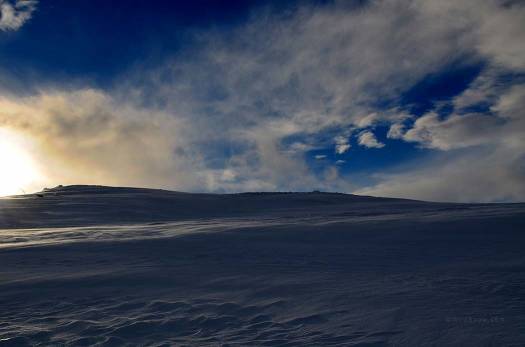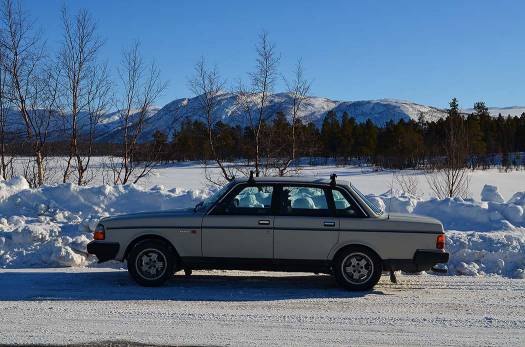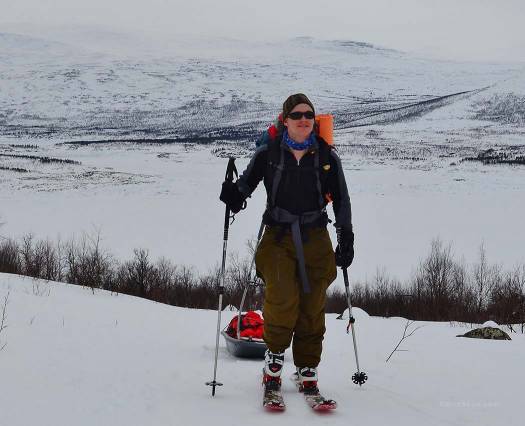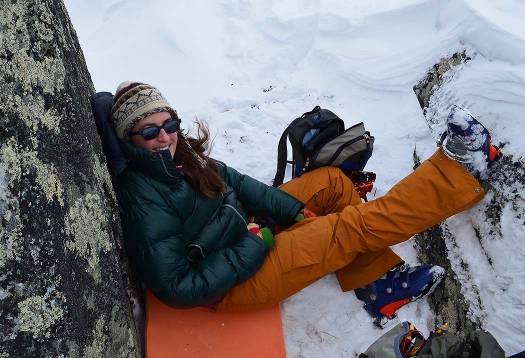Aaron Schorsch
(Editor’s note: Aaron filed a beautiful story with us that we’ve broken into several parts. This is Part 1, see Part 2)
One year ago I was presented with the opportunity to accompany my wife to northern Sweden while she conducted her dissertation research in food anthropology. I jumped at her offer, visions of sunless arctic winter days, herds of reindeer, aquavit, and backcountry ski tours dancing through my head.
Perusing maps of northern Sweden revealed Laponia, the UNESCO World Heritage site composed of a collection of remote mountainous national parks ideal for reindeer herding and ski touring. Believing the dark, cold days would limit my activity, I began writing about my experiences and here I am sharing with you the culinary, cultural, and geographic wonders of this region.
Wikipedia: Lapland is a region in northern Fennoscandia, largely within the Arctic Circle. It stretches across Norway, Sweden, Finland and Russia. On the north it is bounded by the Barents Sea, on the west by the Norwegian Sea and on the east by the White Sea.
I am passionate about food and I managed to weasel my way into a cooking gig at Saltoluokta Fjällstation, a beautiful historic mountain lodge surrounded by Laponia. Luckily, kitchens across the world tend to work similarly, which aided me given that I speak Swedish like a newborn fawn walks. At Saltoluokta, I can ski tour right outside my door before and after work on numerous small peaks that offer fun turns.
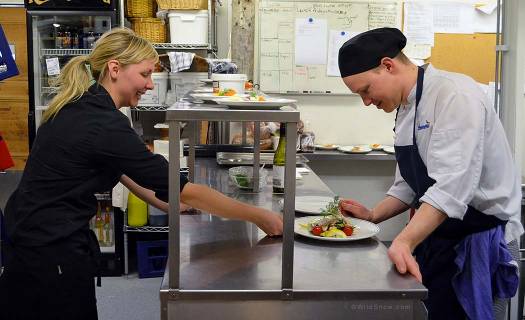
Working in Saltoluokta’s kitchen with Sofia, the only other owner of randonnée skis. Click all images to enlarge.
Following the Kungsleden in Stuor Muorkke National Park
A four day vacation from work prompted me and Amanda, my wife, to explore Stora Sjöfallet, (Stuor Muorkke in the North Sámi language), National Park. We planned a trip along the Kungsleden (King’s Trail) which is a beautiful hiking and skiing trail through the national parks. We rented a fancy pulka (sled) from Outdoor Lapland in Jokkmokk and loaded it with four days of food, clothing, and equipment. On the way we passed reindeer herders’ cabins and impromptu camps of people out fishing on the ice, an obligatory spring tradition in northern Sweden.
In the fjäll, metal-edged, patterned, cross-country touring skis with NNN-BC or 3 pin bindings are practically standard issue. Our backcountry skis (Dynafit Manaslu and Karhu Kodiak) mounted with Dynafit bindings draw some curious, excited, and sometimes skeptical stares. Northern Sweden is very mountainous near the border with Norway, but downhill backcountry skis, especially with tech bindings, are not very popular, perhaps given Swede’s penchant for lagom, or just enough, excitement.
The Sami, the indigenous people of this region also called Sápmi, are often credited with the invention of the ski perhaps some 6000 years ago. Telemark equipment was also developed here. One Swede joked that the low stance of the tele turn allows the skier to perceive the snow as deeper. The theory is plausible. The Swedish fjäll don’t receive record amounts of snow, but consistent cold temperatures keep it around for a long time.
Our trip began at Vakkotavare (many of the names here could be from Lord of the Rings) with a steep climb through a dwarf birch forest. Our pulka pulled against me like a relentless ton of bricks and I experienced several backwards slides before I put on my ski crampons. After toiling our way upward for an hour and half we reached a relatively flat plateau above tree line.
The Kungsleden is marked with blazes on prominent rocks, which all but disappear during the seven months of snow. Winter requires that long slender sticks be placed roughly every 20 meters to mark the way. The southerly wind was at our backs but was reducing visibility to only a few markers at a time. We glided along in the wind and the white, on very gently rising terrain. The pulka followed obligingly, its weight now barely noticeable.
The trail turned and crossed a small ravine and then the poles seemed to disappear downhill. I removed my skins and with the pulka pushing me from behind was able to quickly eat up several kilometers. The clouds lightened for a moment and we were able to look down and see the cabins on the other side of a long, frozen lake called Dievssajávri in Sámi, and Tuesajaure in Swedish.
The gradient increased a little and we descended into another dwarf birch forest where I was able to carve turns while the pulka followed, powersliding in the turns (the pulka has rigid pole attachments). We were happy to have our fixed heel skis as we easily skied through the trees. The wind on the lake was fierce but we skated and poled our way across. A final minuscule uphill at the edge of the lake made us appear like ducks as we ungracefully struggled the final meters on our skinless skis.
(We’ll have Parts 2 & 3 up in a few days.)
(We’re having the usual trouble getting Google maps to embed, try this link.)
(Guest blogger Aaron Schorsch is a chef, carpenter, farm hand, teacher, and baker who loves food, skiing, travel, canoeing and writing. He calls home wherever the snow is falling and the rivers are rushing, which is most often western Oregon. He is currently living above the Arctic Circle in northern Sweden with his wife Amanda. Check out his blog, Saveur The Journey.)
Beyond our regular guest bloggers who have their own profiles, some of our one-timers end up being categorized under this generic profile. Once they do a few posts, we build a category. In any case, we sure appreciate ALL the WildSnow guest bloggers!

